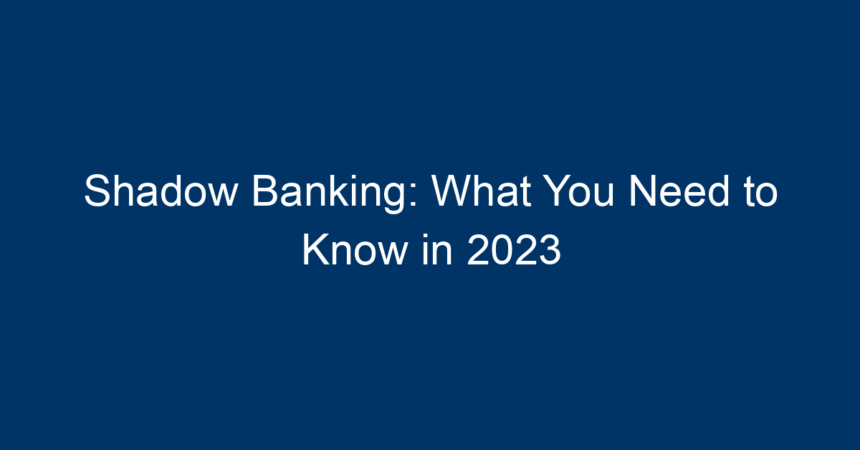In the intricate world of finance, one term is generating waves of curiosity and concern—shadow banking. As traditional banks tighten regulations and rein in lending practices post-financial crises, an alternative system of financing has emerged, largely operating outside the formal banking sector. If you’re eager to understand what shadow banking entails and its implications for the global economy in 2023, you’ve landed in the right place. This article will unpack the concept, its significance, associated risks, and future trends that could shape your financial decisions.
What is Shadow Banking?
Shadow banking refers to a network of financial intermediaries that provide services similar to traditional banks but operate outside of regulation. These entities can include hedge funds, private equity firms, money market funds, and various other financial institutions. By avoiding traditional regulatory frameworks, these bodies can lend money, manage investments, and perform other financial services with far greater flexibility.
Key Characteristics of Shadow Banking
- Lack of Regulation: Unlike traditional banks, shadow banking institutions often lack the same level of oversight, allowing them to take on riskier financial activities.
- Maturity Transformation: Much like banks, shadow banks borrow short-term and lend long-term, which can create vulnerabilities in financial stability.
- Complex Financial Products: Shadow banking often involves structured products and derivatives, adding layers of complexity to financial transactions.
The Rise of Shadow Banking
The rise of shadow banking can largely be attributed to the constraints imposed on traditional banks following the 2008 financial crisis. As these banks faced increased capital requirements and stricter lending practices, businesses and consumers alike sought alternative avenues for credit. This paved the way for non-bank financial intermediaries to flourish, leading to a shadow banking system that is now estimated to be worth trillions of dollars globally.
Growth Factors
- Deregulation: A relaxation of regulations in some regions has encouraged the growth of shadow banking.
- Technological Innovation: Fintech growth has allowed shadow banking institutions to operate more efficiently, reaching millions of customers with innovative solutions.
- Market Demand: In times of economic uncertainty, businesses often turn to shadow banks for quicker access to loan approvals and capital infusion.
The Role of Shadow Banking in the Economy
Shadow banking plays a critical role in providing credit to sectors that may be underserved by traditional banks. It supports startups, small businesses, and consumers looking for more flexible financial options.
Benefits of Shadow Banking
- Increased Credit Availability: For many, shadow banks provide easier access to capital, especially in markets where traditional banks hold a conservative stance.
- Innovative Financial Solutions: The flexibility of shadow banks allows them to offer tailored products that can suit the diverse needs of businesses and consumers.
- Market Competition: The existence of shadow banks introduces competition, often leading to better services and reduced costs for borrowers.
Challenges Faced by Shadow Banks
- Systemic Risk: The interconnectedness of shadow banks and traditional banks can expose the entire financial system to risks.
- Lack of Transparency: With limited oversight, it can be challenging for regulators and investors to understand the true risk profile of shadow banking operations.
- Consumer Risks: Individuals who engage with shadow banks may face higher costs and risks, particularly if they are not fully aware of the terms and implications associated with borrowing.
Regulatory Responses to Shadow Banking
As the shadow banking sector expands, regulatory bodies around the world are beginning to take notice. The goal is to mitigate risks while still allowing the benefits of shadow banking to flourish.
Global Regulatory Initiatives
- Basel III Framework: Aiming to improve regulation, supervision, and risk management within the banking sector, Basel III indirectly impacts shadow banking by enforcing stricter capital requirements.
- FSB Recommendations: The Financial Stability Board (FSB) has issued recommendations focusing on monitoring and regulating shadow banking activities that may pose risks to financial stability.
- Country-Specific Regulations: Many countries have begun developing their own specific regulations to oversee shadow banking activities, ensuring that they align with international standards.
Future Trends in Shadow Banking
As we move forward into 2023 and beyond, several trends will likely shape the landscape of shadow banking.
Digitalization and Fintech
The evolution of technology is a game-changer. Fintech companies are increasingly participating in shadow banking, utilizing big data and AI to streamline operations and assess credit risks more effectively. Innovations such as blockchain and peer-to-peer lending platforms will continue to gain traction, making shadow banking even more accessible to the average consumer.
ESG Considerations
Environmental, Social, and Governance (ESG) factors are becoming paramount for investors. Shadow banks that focus on sustainable investing could see a significant rise in demand from socially conscious consumers.
Increased Scrutiny
As shadow banking grows, so too will the focus on regulation. Expect increased scrutiny from governments worldwide as they attempt to mitigate systemic risks while capitalizing on the benefits offered by this non-traditional banking sector.
Act Now: Navigating the Future of Shadow Banking
- Stay Informed: Understanding the evolving landscape of shadow banking is essential. Keep abreast of regulatory changes and emerging financial products.
- Make Informed Decisions: Evaluate the pros and cons of engaging with shadow banks. Ensure you fully understand the terms and risks involved.
- Diversify Your Financial Portfolio: While shadow banking can offer valuable resources, consider balancing your investments across different asset classes and financial institutions.
Conclusion
Shadow banking is a complex yet increasingly relevant component of the global financial system in 2023. While it offers substantial benefits like increased credit availability and innovative solutions, the associated risks cannot be ignored. As regulatory frameworks continue to evolve and technology reshapes the landscape, both consumers and businesses must stay informed and navigate this intricate world with caution.
By understanding shadow banking’s nuances, you can make more confident financial decisions in the modern economy. Remember, knowledge is power—stay informed and proactive as this dynamic financial sector unfolds before us.




